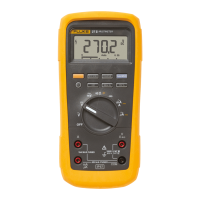27
Service Manual
2-4
therefore, it may be helpful to refer to the schematic located near the back of this
manual.
2-4. Input Overload Protection
Overload protection for the volts/ohms/diode-test input (J1) is provided by a network of
five metal-oxide varistors (RV1 through RV5) a current-limiting resistor (R2) and a
thermistor (RT1).
A 44/100A, 1000 V fuse provides protection for the mA/µA input (J2) current shunts. An
11 A, 1000 V fuse provides protection for the 10 A input (J3) current shunt. In addition,
for the µA and mA ranges, a bridge rectifier (U7) and four diodes (CR1, CR2, CR3,
CR4) ensure that the fuses (instead of the shunts) open in very high current overload
conditions.
Transistors Q1, Q2, and Q1 provide additional overload protection for the millivolt and
ohms functions. If sufficient overload voltage is present, the transistors turn on and
connect that input to common through limiting resistors R2 and RT1, thereby protecting
the circuitry in U1. A clamp circuit (CR6 and Q15) connected to the volt/ohms/diode-
test input through Z1 and C3 provides similar protection for the volts/ohms/diode-test
input.
2-5. Function Switching Circuits
Input signals are routed from the overload protection circuits to the function switch. The
function switch is a rotary switch with two double-sided wafers which provide the
necessary switching to select each of the various functions. In addition, battery voltage is
routed through the function switch from the battery voltage regulator to U1, and from U1
to U2.
2-6. Signal Conditioning Circuits
Each input signal is routed through signal conditioning circuitry before reaching U1.
Input signals received through the volts/ohms/diode-test input (J1) are routed through
Z1, a precision resistor network. The resistor network provides precise input scaling for
the various voltage ranges, and it provides precision reference resistors for the ohms
function. The capacitors in parallel with the various resistors in Z1 are used in the ac
voltage functions; the variable capacitors provide calibration adjustment for the high
frequency ac ranges.
Current inputs received through the mA/ µA input (J2) and the A input (J3) develop a
voltage across shunt resistors R14, R20, and R23 (320 µA, 32 mA, and 10 A
respectively). Resistors R9 and R10 comprise a 10:1 divider for the 3200-µA and 320-
mA current ranges.
2-7. Custom Analog IC (U1)
The analog-to-digital converter, autorange switching, and most of the remaining active
analog circuitry (including additional signal conditioning) are contained in U1, a custom
LSI package. Peripherals to U1 include the system clock, the reference voltage regulator
for the A/D converter, and some filtering and amplifier stabilization components. U1
also contains digital circuitry for state machine control over the A/D decoding ROMs for
analog switch drive and read counter preset, and registers to store control outputs from
the microcomputer.
Analog-to-digital conversion is accomplished within U1 using a modified dual-slope
A/D converter circuit, as shown in Figure 2-2. The conversion method in the Fluke 27
can be described as a charge-coupled, multiple-slope technique. A series of 10 minor

